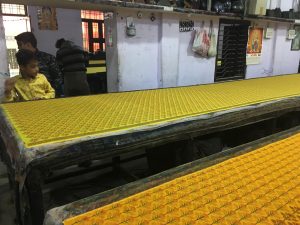It’s a winter afternoon and we are off, a friend and I, travelling south, leaving the city of Jaipur behind. But, barely twenty minutes into the ride, our driver pulls up on the side of the road and calls the number of our craftsman.
“We have crossed Gnadha Nala, ( Dirty canal),” he says.
We had just crossed a bridge with what looks like a creek running under it.?Almost immediately,a young boy in glasses runs up and directs our car. We turn into a dirt track and then the car stops at tiny courtyard. Vehicles can go no farther. We get off and I see Santhosh Kumar Dhanopia, a welcoming smile on his face.
We follow him into another lane that has the homes sitting almost on top of it with the doors opening right in to it. What should have looked anachronistic looks right at home here.?Dhanopia’s workshop is near the end of the lane.
“We work on the ground floor and live on the first,” he says, the significance of which would strike me only much later.
The workshop is a large room, with a tall ceiling and long work benches. Yards of fabric are stretched over these benches. There are workmen diligently printing over these with hand held blocks, Today they are working on Yellow.

We meet Santhosh Kumar’s brother there, ?also is a block printer.
“How does this block printing work?” I ask.
“First we choose the cloth, which we buy directly from weavers. This yellow fabric you see is cotton from South India.”
“Then we decide on the specific design and the colours we want to put in it.”
“The printing process starts with printing the outline of the design.”
“Once the outline is done, we print over it, one element of the design at a time, for every part of the design that we want in a different colour.”
“So in this design, first we printed the over-all flower . Then we printed green leaves, now they are doing the red buds and so on till we finish.”
“Do you know, this is actually not green but a shade of blue? That it becomes this green-blue after printing?”
Seamlessly, flawlessly, like the designs on their cloth, the two brothers pick up the story as each one lets off and we no longer know who told us what.
Two little boys run into the room. The elder one is Santhosh Kumar’s son, the one who guided us on the road and the younger one, his brother’s child.
“I saw you in Mumbai at the exhibition,” the elder one tells me.
“You recognise me?” I wonder aloud. ?”Of course.” He’s scornful and I am flattered .
“Will he come into the craft?” I ask.
“He’s already learning.” is the proud reply
“And the younger one?”
“Of course. We cannot let our skill die out,” is their answer and I get a glimpse of the artists’ soul.
I comment on the hundreds of blocks crammed on shelves that cover an entire wall, shelves that resemble the bookcase of demented booklover.
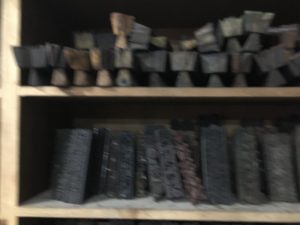
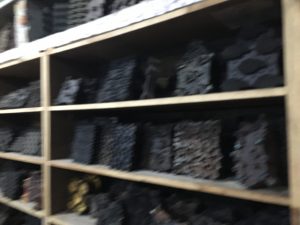
They get animated and generously share their blocks with me
Look at this one. See how small the designs are.?( this is a zoomed-in image, of course)
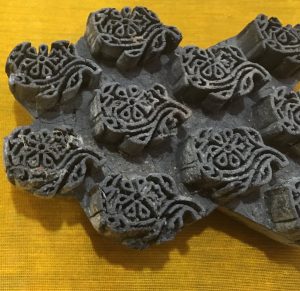
And this one is more than a hundred years old. Our grandfather’s.
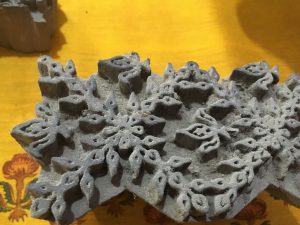
This won me (Santhosh Kumar Dhanopia) an award.
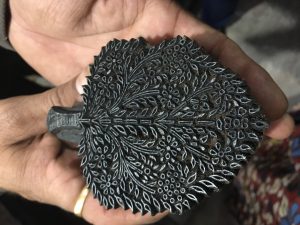
We also have have blocks that depict our everyday village life. Like this , a paanihari.
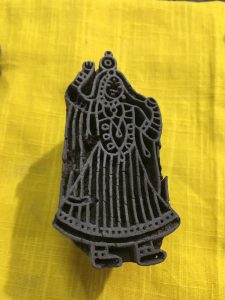
(and I am reminded of the importance of water-bearer in this desert landscape.)
Here’s another – The saanpera and nag. ( the snake charmer and the cobra)
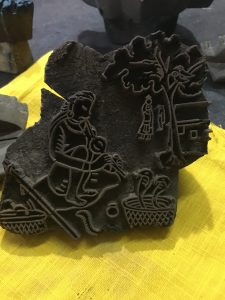
We normally work only with wood. But recently we made this one with brass, see. The design was too intricate and we will be using it a lot, The wood disintegrates . So we used brass to carve out the pattern.
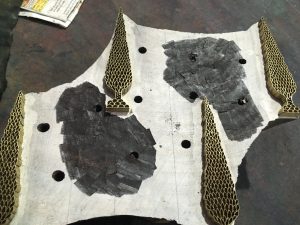
There is only one man making these blocks. The new block makers don’t want to make intricate ones. When this block maker passes on, this kind of blocks will come to an end, they say.
That leads, naturally, to preservation of the blocks.
” In refined oil. Earlier we use to Ghani oil but now we find it easier to use refined oil. They are soaked in int for a period of six months after which they are taken into use. From the oil tub to the colouring trays.”
They show me the trays of colours that are near the printing table.?Colours are made form minerals, mud and vegetable dyes. These are the colours we are currently working with- red and blue.
“Come , let go see the finised products,” they say and takes us to the adjoining studio
We cross the front porch to get there. A large Belgium shepherd, almost the size of a tiny pony, is tethered there, imposing in a red coat, a nod to the weather. But Jack is so house-broken, he barely flicks us a glance.
The studio is filled with textiles. Santhosh and his family work with khadhi, cottons, mulmul, silk-cottons and tussars. He makes yardage, sarees, stoles and dupattas. He also dabbles in bagru and dabu but Sanganer block prints are his speciality,
A typical sanganer print
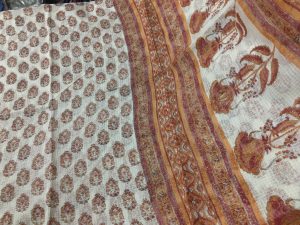
His award winning design. The design is too intricate for my camera to do it any justice but I share a long-view of it anyway.
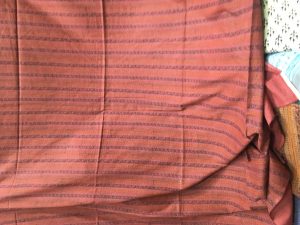
A ?design ?and it’s ?scaled down version .
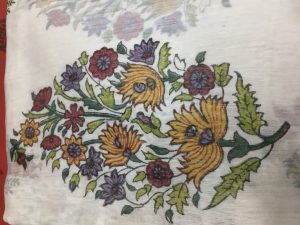
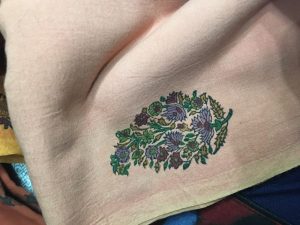
And a black-white-red one that caught my eye
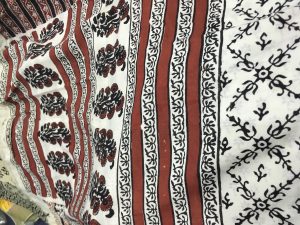
His mother comes by. She used to do block printing too, we learn. A little later , the father comes by, who also used to print. But the parents, like their ?forfathers , used to do block printing in their apsare time. Now the Dhanopis brothers are engaged ?in it full itme. The boys drop in and we learn that the ?little 12 year ofd has just started to learn
His part of the fabric :
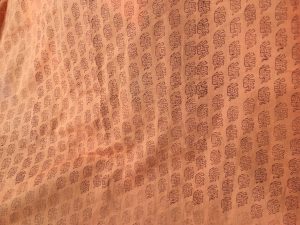
“It was wonderful to have you,” they say as we leave,. I mutter inanaites ,not having the words to thank him for letting me have a glimpse of ?a world where tradition, art and history, entwined in the fabric of Family, come alive every single day..
Santhosh Kumar Dhanopia lives and works at
29, Ganesh Colony
Sanga Setu Road
Sangaer , Jaipur 302029
Ph: + 91 9887788434
by Maya Sharma Sriram.?

